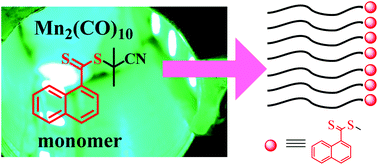a Jiangsu Key Laboratory of Advanced Functional Polymer Design and Application, Department of Polymer Science and Engineering, College of Chemistry, Chemical Engineering and Materials Science, Soochow University, Suzhou, P. R. China
Polym. Chem. 2014, 5, 4641-4648
Methyl methacrylate was polymerized in the presence of dimanganese decacarbonyl [Mn2(CO)10]/2-cyanoprop-2-yl-1-dithionaphthalate (CPDN) via a photo-induced controlled radical polymerization under visible (green LED with λmax of 565 nm) or sunlight irradiation at a moderate temperature. The manganese carbonyl [Mn2(CO)10] served as the light absorbing component, whereas 2-cyanoprop-2-yl-1-dithionaphthalate (CPDN) served as pseudo-alkyl halide initiator and mediating agent. The polymerization showed the characteristic behaviour of a living polymerization such as linear kinetics; the molecular weight of the polymers linearly increased with monomer conversion, and the obtained polymers showed a narrow molecular weight distribution under appropriate conditions. The obtained polymers exhibited high degree of chain end functionality, which could be used for further chain extensions, either through a traditional thermally initiated RAFT polymerization or through a light-irradiated LRP in the presence of [Mn2(CO)10]. The possibility of stopping and restarting the polymerization process was realized simply by turning off or on the LED light.

链接:
//pubs.rsc.org/en/content/articlelanding/2014/py/c4py00509k#!divAbstract